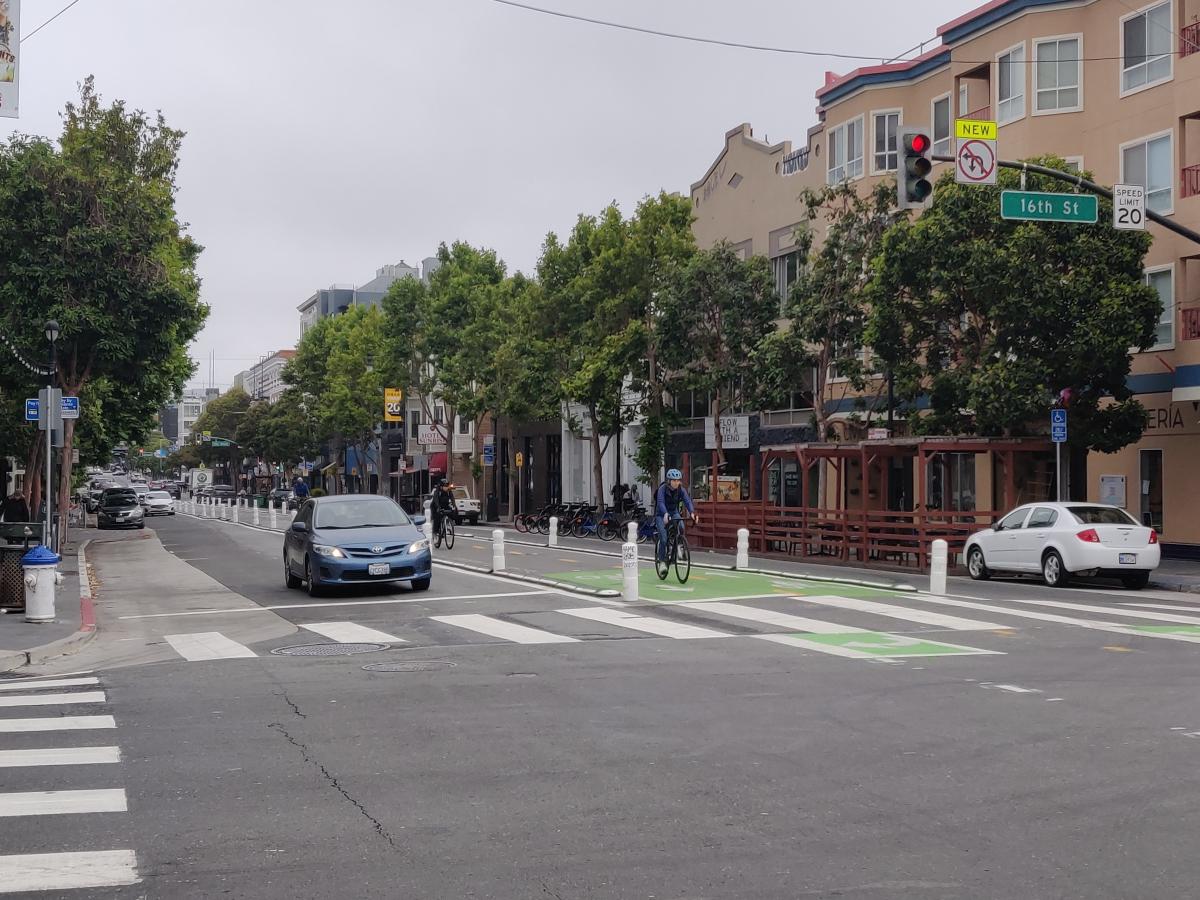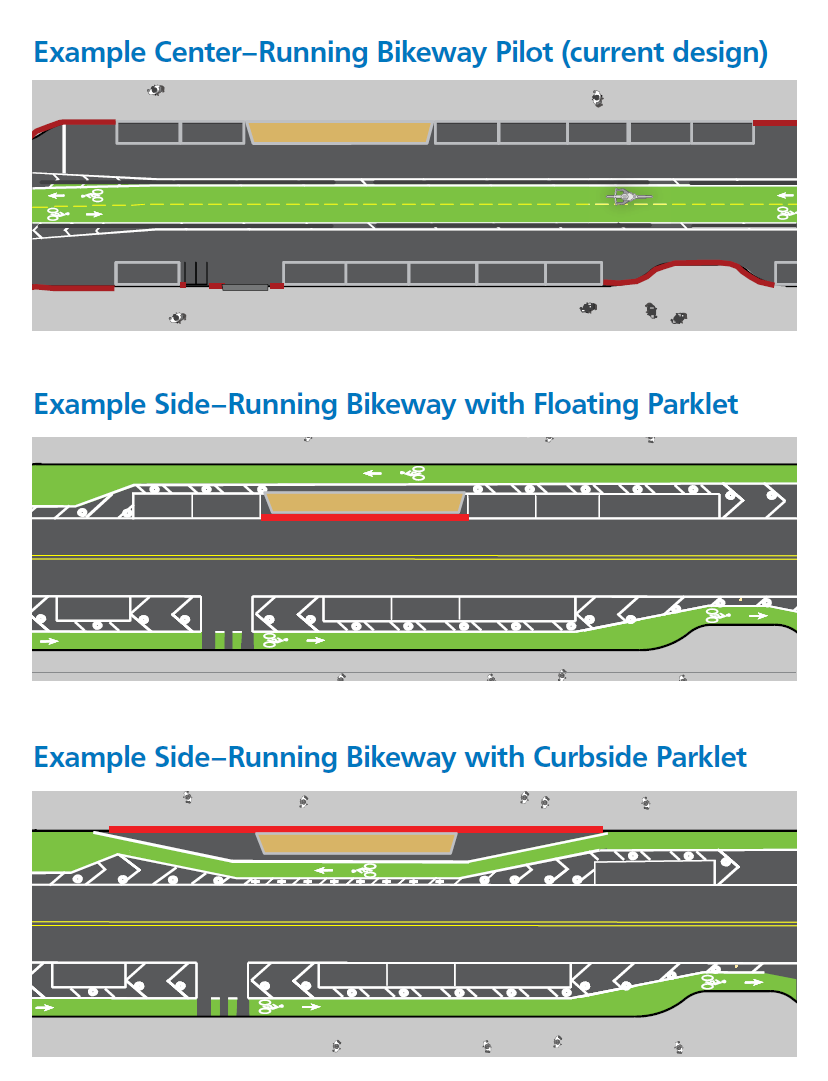Valencia Bikeway Improvements - February 2024 Project Update

We installed the center-running pilot on Valencia Street in August 2023. This is a beloved corridor, and we innovated by trying something new. We're 100% committed to learning from the pilot, so we're happy to see people who live, work and travel on Valencia share feedback. Already, we've received hundreds of emails, phone calls and petitions.
We're also determined to share information transparently -- and to make changes if the pilot's not working. In this update, we'll answer some of the top questions we’ve received. We'll also explain where we are, how we got here and where we’re going.
Why did the SFMTA install center-running bike lanes?
To understand how we got to the center-running pilot, we have to go back in time to just before the pandemic. The previously unprotected side-running bike lanes were not working. There was rampant double parking in the bike lane. There were conflicts between bicycles and cars pulling in and out of the bike and parking lanes to load. Cyclists were getting doored. On average, the corridor saw two serious injury collisions a month.
So, in early 2020 we proposed a protected side-running bike lane between the sidewalk and cars parked on the street. We had already installed a short stretch of protected side-running bike lanes in 2019 between 15th and Market streets (where the street is wider). This was a huge success. And then Covid happened.
Dozens of Shared Space parklets were installed along the corridor and were a lifeline to businesses who were hanging by a thread. Demand for curb space exploded as food deliveries surged in popularity. The side-running bike lane proposal suddenly became more complicated. To install curbside bike lanes without disrupting parklets, the lanes would have to weave around parklets, wiping out a lot of parking and loading spaces. So, to support our small businesses, we looked to an underused segment of the street -- the median.
The current center-running pilot addresses some key concerns. It:
- Allows for physical separation between vehicles and bike traffic
- Maximizes the curb space for customer parking, business loading and parklets
- Meets emergency vehicle access needs
And while we have heard many concerns, we’ve also heard feedback from cyclists who feel safer now having a protected lane.
When will the evaluation results for the pilot be released?
It takes time to both collect and analyze data, and the Valencia project team has collected a massive amount of it — twice as much as a typical project. Here’s what we’re evaluating:
- Bicycle, pedestrian and vehicle volumes
- Vehicle loading, pickups and drop-offs
- Vehicle speeds and congestion
- Encroachment into bike lanes
- Traffic collisions and conflicts
- Compliance with turn restrictions and bike signals
The team is now finalizing the three-month evaluation report. Preliminary data shows that average daily bike volume is about 3% higher with the center-running protected bikeway compared to pre-pilot conditions. The full three-month evaluation report will be shared at an informational meeting of SFMTA’s Board of Directors on February 20.
Major street changes can be hard to adapt to; it typically takes several months for people’s behavior to change and new habits to form. So, it's important to note that the first few months of data may not be as telling as in future months. The project team also plans to develop reports sharing data at the six- and 12-month marks.
Why can’t we just move the bike lane to another street?
Valencia has long been a major destination for people on bikes. Valencia is also the most important north-south bike route in the city. It connects directly to the protected bikeway on San Jose Avenue that serves the southern neighborhoods and to Market Street, our most important east-west bikeway. All the streets to the west are too steep, and the streets to the east have poor connections on either end.
A customer survey showed that 8% of shoppers along Valencia arrived by bike and 38% arrived by foot. Valencia's previous design was failing those customers in part due to a huge increase in delivery services using the bike lane. We need to make sure that customers feel welcome arriving to Valencia businesses on a bike.
What about other options?
We can’t go back to the way things were because it just wasn’t safe — this stretch of Valencia had one of the highest collision rates in the city. However, we’ve heard a lot of feedback that the center-running pilot isn’t working for everyone either. We’ve recently made some adjustments to improve curb space needs for merchants. While we still need to evaluate the pilot, we are simultaneously turning over every last stone as we look into design alternatives.
We are eager to study more ambitious ideas for Valencia, including pedestrianization or making the street one-way for cars. However, all those options require significant capital investment. They also require working closely with merchants and residents to address access, loading and other needs. It will take years to get consensus on design and identify capital funding. While we do that long-term work, we want to make sure that we address immediate safety concerns, using quick-build techniques and a pilot approach.
Are we considering side-running bike lanes now?
All of this brings us back to side-running protected lanes. These could be implemented more quickly, but there are some difficult tradeoffs to consider with this design.
For businesses with Shared Spaces, keeping parklets at the curb means losing two additional parking spaces per parklet for the bike lane to go around the parklet. When we pivoted from the original side-running plan and installed a nonstandard center-running bikeway, it was to preserve the parklets and customer parking. We'd love to move back to the original side-running plan. This could work if parklets were moved from the curbside to “floating” parklets with a bikeway running between them and the sidewalk.
Floating parklets are common in New York and can be found on Telegraph Avenue in Oakland, but they are more complex. We will be exploring this option with Valencia merchants and talking through the mechanics, including accessibility requirements and how staff and customers will cross the bike path to access the parklets. We know that moving a parklet will cost money and we’re looking into how this could be funded. We also know that it won't work for every merchant, but we are learning from case studies around the country. We believe it could work on Valencia too!


Image is from a floating parklet in Oakland.
Another consideration is providing enough space for emergency vehicles while maintaining parking on both sides of the street.
So when we talk about Valencia… well, “it’s complicated.” But our goals are clear, and we continue to have conversations with the community and to work towards a solution that is both safe and supports the vitality of this incredible part of San Francisco.
